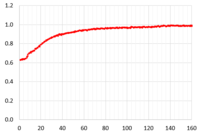Hello,
I would need help in fitting a curve to the following data, I have several curves and I need to find the equation of the best fit curve of each graph to combine them and find an overall equation. Excel best fit curves yield curves that are not close enough. Someone mentioned an exponential curve like 1-e^x but not sure this is a correct equation because it doesn't work with me, somehow looks like exponential but not sure of the correct equation. Would appreciate the help.

I would need help in fitting a curve to the following data, I have several curves and I need to find the equation of the best fit curve of each graph to combine them and find an overall equation. Excel best fit curves yield curves that are not close enough. Someone mentioned an exponential curve like 1-e^x but not sure this is a correct equation because it doesn't work with me, somehow looks like exponential but not sure of the correct equation. Would appreciate the help.




